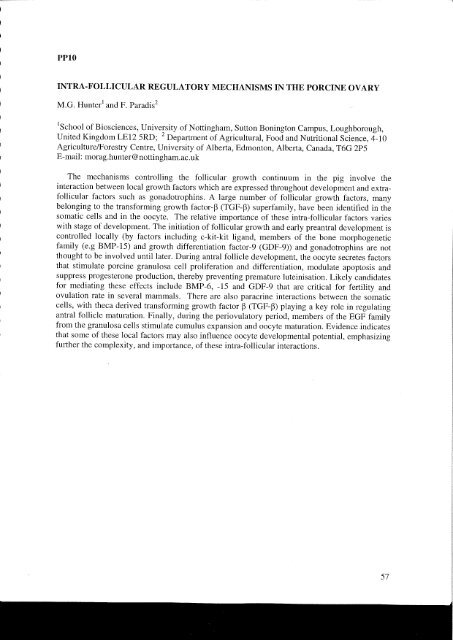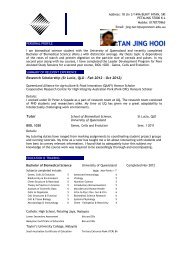Untitled - Pork CRC
Untitled - Pork CRC
Untitled - Pork CRC
Create successful ePaper yourself
Turn your PDF publications into a flip-book with our unique Google optimized e-Paper software.
I<br />
I<br />
I<br />
I<br />
I<br />
PPlO<br />
I<br />
I<br />
INTRA.FOLLICULAR REGULATORY MECHANISMS IN THE PORCINE OVARY<br />
I<br />
M.G. Hunterl and F. Paradis2<br />
I<br />
I<br />
I<br />
I<br />
rSchool of Biosciences, University of Nottingham, Sutton Bonington Campus, Loughborough,<br />
United Kingdom LEl2 5RD; 2 Department of Agricultural, Food and Nutùtional Sóience, 4-10<br />
AgricultureÆorestry Centre, University of Alberta, Edmonton, Alberta, Canada, T6G 2P5<br />
E-mail: morag.hunter@nottingham.ac.uk<br />
I<br />
I<br />
I<br />
I<br />
I<br />
)<br />
i<br />
I<br />
I<br />
I<br />
I<br />
The mechanisms controlling the follicular growth continuum in the pig involve the<br />
interaction between local growth factors which are expressed throughout development and extrafollicular<br />
factors such as gonadotrophins. A large number of follicular growth factors, many<br />
belonging to the transforming growth factor-B GGF-B) superfamily, have been identified in the<br />
somatic cells and in the oocyte. The relative importance of these intra-follicular factors varies<br />
with stage of development. The initiation of follicular growth and early preantral development is<br />
controlled locally (by factors including c-kit-kit ligand, members of the bone morphogenetic<br />
family (e.g BMP-15) and growth differentiation factor-9 (GDF-9)) and gonadorrophins are nor<br />
thought to be involved until later. During antral follicle development, the oocyte secretes factors<br />
that stimulate porcine granulosa cell proliferation and differentiation, modulate apoptosis and<br />
suppress progesterone production, thereby preventing premature luteinisation. Likely candidates<br />
for mediating these effects include BMP-6, -15 and GDF-9 that are critical for fertility and<br />
ovulation rate in several mammals. There are also paracrine interactions between the somatic<br />
cells, with theca derived transforming growth factor P (TGF-P) playing a key role in regulating<br />
antral follicle maturation. Finally, during the periovulatory period, members of the EGF family<br />
from the granulosa cells stimulate cumulus expansion and oocyte maturation. Evidence indicates<br />
that some of these local factors may also influence oocyte developmental potential, emphasizing<br />
further the complexity, and importance, of these intra-follicular interactions.<br />
57



